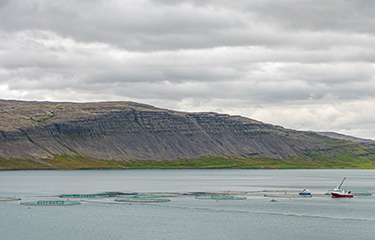Iceland’s government has proposed a new legal framework that provides a roadmap for the development of the country’s fast-growing salmon farming industry.
The proposal, presented by Icelandic Food, Fisheries, and Agriculture Minister Svandís Svavarsdóttir, heavily emphasizes the control, monitoring, and research of aquaculture production to meet stringent requirements to minimize environmental impact and to ensure animal welfare and aquatic disease control. The government will offer economic incentives to encourage operators to invest in the best available equipment, work methods, and skilled personnel, and funds will also go toward research, monitoring, and licensing activities.
Within the draft strategy, which comprises a detailed action plan up until 2028 but extends to the year 2040, is a proposal for producers to pay for their use of natural resources and for there to solely be one operator permitted in each fjord.
“Taking fees from the sector must reflect that it is a matter of using limited resources,” Svavarsdóttir said. “It is fundamental that those who profit from the use of the country's natural resources pay a fair price for it. But it is equally important that we set ourselves ambitious, measurable goals in environmental matters and set a timetable on the way to those goals.”
The policy also proposes that license-holders pay a “fair fee” to support the administration, research, and monitoring of resource use and infrastructure development. A division of the fee between the federal government and municipalities will aim to ensure local authorities can finance the infrastructure and service development required for sector growth.
There are currently approvals in place for 103,000 metric tons (MT) of Atlantic salmon production in net pens in Iceland. If the plan is approved, no new licenses will be administered until 2028. Under the plan, a restructuring of farming licenses in the Austfjord and Westfjords regions would result in just one operator receiving permission to use each fjord or sea area starting in 2028.
The draft policy is now in the government's consultation portal, and the deadline for public comment is 4 November. The action plan will undergo an annual update if and when the policy comes into force.
The Iceland government’s proposal follows an administrative audit of the industry conducted by the Icelandic National Audit Office (INAO) earlier in 2023. The audit examined several wide-ranging issues, from the preparation of legislation to the supervision of company activities in the sector, and made 23 suggestions for the government’s handling of the salmon aquaculture sector, 17 of which targeted operations governed by the Iceland Ministry of Food, Fisheries, and Agriculture.
In salmon production terms, Iceland has come a long way in a short period. Overall farmed finfish production has been growing at a compound annual growth rate (CAGR) of 35 percent since 2016, and net-pen salmon farming has become the main driver of the country’s aquaculture growth. With total production reaching 43,000 MT in 2022 and expected to exceed 60,000 MT in 2023, it has become one of the fastest-growing fish-farming sectors globally.
Svavarsdóttir’s new proposal takes this growth into account, stating ...
Photo courtesy of Oleg Senkov/Shutterstock








